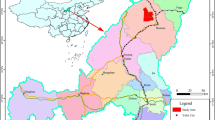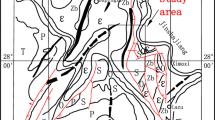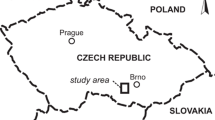Abstract
Management of large quantities of water from a mine site is generally considered in the initial mine plan, but has to be refined as mining progresses. Evaluating and forecasting groundwater ingress to a mine are necessary. Based on a conceptual hydrogeological model of Vietnam’s Thach Khe iron mine and the area surrounding it, a calibrated numerical groundwater model was developed and various scenarios were assessed to estimate groundwater ingress at different stages of the mine life. Groundwater flows into the mine site during eight periods, from the fourth year to the projected end of mining, were forecasted by the numerical model. The total groundwater is steadily increasing from 2800 to 14,450 m3/h. Comparing the modeling result with actual observations showed that the forecast modeling result was 4.1% higher than the observed results. Therefore, the hydrogeological conditions and selected parameters in the model appear reasonable.
摘要
矿井在规划阶段就应考虑采场巨大涌水量的管理,而且在开采期间还要进一步技术细化。评价和预测涌水量对一个矿井必不可少。基于越南Thach Khe 铁矿及周围的水文地质概念模型,建立了校正的地下水流数值模型,预测了矿井在不同开采阶段的涌水量。利用该数值模型预测了从第四年到计划开采结束的八个阶段的涌水量。总涌水量将由2,800 m3/h稳定增长至14,450m3/h。与涌水量实际观测结果对比,模型预测值比实际观测值高4.1%。因此,模型的水文地质条件和选取参数合理。
Zusammenfassung
Der Umgang mit hohen Wassermengen, welche einem Bergwerk zutreten, ist normalerweise Gegenstand von Betrachtungen in initialen Rahmenplänen. Während des Abbauprozesses werden diese Angaben jedoch verfeinert. Notwendigerweise müssen allerdings auch Berechnungen und Vorhersagen des Grundwasserzuflusses erfolgen. Basierend auf einem konzeptionellen hydrogeologischen Modell der Thach Khe Eisenmine (Vietnam) und ihrer Umgebung wurde ein numerisches Grundwassermodell entwickelt und kalibriert. Hiermit sind verschiedene Szenarien berechnet worden, um den Grundwasserzufluss zu unterschiedlichen Zeitpunkten der betriebsdauer des Bergwerks zu ermitteln. Der Grundwasserzufluss in das Bergwerk wurde mit dem numerischen Modell berechnet und in acht Stadien, beginnend ab dem vierten Betriebsjahr bis zum Ende des Betriebs prognostiziert. Die Zulaufmenge nimmt kontinuierlich von 2.800 auf 14.450 m3/h zu. Der Vergleich der Prognosen mit aktuellen Beobachtungen zeigt, dass die Modellvorhersagen um 4.1% höher lagen als die Messungen. Aus diesem Grund wird eingeschätzt, dass die im Modell verwendeten Randbedingungen und Parameter sinnvoll gewählt worden sind.
Resumen
El manejo de grandes cantidades de agua de un sitio minero es generalmente considerado en el plan inicial de la mina, pero tiene que ser refinado a medida que avanza la explotación minera. Es necesario evaluar y pronosticar el ingreso de agua subterránea a una mina. Basado en un modelo hidrogeológico conceptual de la mina de hierro Thach Khe de Vietnam y el área que la rodea, se desarrolló un modelo numérico calibrado de agua subterránea y se evaluaron varios escenarios para estimar el ingreso de agua subterránea en diferentes etapas de la vida de la mina. El modelo numérico pronosticó los flujos de agua subterránea en el sitio de la mina durante ocho períodos, desde el cuarto año hasta el final proyectado de la minería. El agua subterránea total está aumentando constantemente de 2.800 a 14.450 m3 / h. La comparación con las observaciones reales mostró que el resultado del modelo de pronóstico era un 4,1% más alto. Por lo tanto, las condiciones hidrogeológicas y los parámetros seleccionados en el modelo parecen razonables.














Similar content being viewed by others
References
Aquaveo LLC (2007) Groundwater modeling system, version 6.5.6. UT, Provo
Bahrami S, Ardejani FD, Aslani S, Baafi E (2014) Numerical modelling of the groundwater inflow to an advancing open pit mine: Kolahdarvazeh pit, central Iran. Environ Monit Assess 186(12):8573–8585
Delleur JW (2010) The handbook of groundwater engineering, 2nd edn. CRC Press, Boca Raton
Dong D, Sun W, Xi S (2012) Optimization of mine drainage capacity using FEFLOW for the no. 14 coal seam of China’s Linnancang Coal Mine. Mine Water Environ 31(4):353–360
Franke OL, Reilly TE (1987) The effects of boundary conditions on the steady-state response of three hypothetical ground-water systems—results and implications of numerical experiments. USGS water-supply paper 2315
Franke OL, Reilly TE, Bennett GD (1987) Definition of boundary and initial conditions in the analysis of saturated ground-water flow systems—an introduction. USGS Tech Water Resour Investig 3:B5
Hernández JH, Padilla F, Juncosa R, Vellando PR, Fernández Á (2012) A numerical solution to integrated water flows: application to the flooding of an open pit mine at the Barcés river catchment—La Coruña, Spain. J Hydrol 472:328–339
Hofedank RH (1979) Computation of and experience on lignite opencast mine drainage. Proc, 1st International Mine Drainage Symp. O.G.C. Engineers, Denver, pp 383–408
Konikow LF, Bredehoeft JD (1978) Computer model of two dimensional solute transport and dispersion in groundwater. USGS Water Resource Invest, Book7, ch 2
Lewis R (1999) Predicting the steady-state water quality of pit lakes. Min Eng 51(10):54–58
Marinelli F, Niccoli WL (2000) Simple analytical equations for estimating ground water inflow to a mine pit. Groundwater 38(2):311–314
McWhorter DB (1981) Predicting groundwater response to disturbance by mining-selected problems. Proc, Symp Surface Mining, Hydrology, Sedimentology and Reclamation, Univ of Kentucky, pp 89–95
Moench AF (2004) Importance of the vadose zone in analyses of unconfined aquifer tests. Groundwater 42(2):223233
Morrissey DJ (1989) Estimation of the recharge area contributing water to a pumped well in a glacial-drift, river-valley aquifer. USGS Water Supply Paper 2338
Prakash A (2000) The handbook of groundwater. J Hydraul Eng 126(10):797–798
Reilly TE (2001) System and boundary conceptualization in ground-water flow simulation. Appl Hydraulics USGS Book 3, ch B8
Reilly TE, Pollock DW (1993) Factors affecting areas contributing recharge to wells in shallow aquifers. USGS Water-supply paper 2412
Singh R, Atkins A (1984) Application of analytical solutions to simulate some mine inflow problems in underground coal mining. Int J Mine Water 3(4):1–27
Singh R, Atkins A (1985a) Analytical techniques for the estimation of mine water inflow. Int J Min Eng 3(1):65–77
Singh R, Atkins A (1985b) Application of idealised analytical techniques for prediction of mine water inflow. Min Sci Technol 2(2):131–138
Singh R, Reed S (1987) Estimation of pumping requirements for a surface mining operation. Proc, Symp. on Pumps and Pumping, Nottingham Univ, UK, pp 1–24
Singh R, Ngah S, Atkins A (1985) Applicability of current groundwater theories for the prediction of water inflows to surface mining excavations. Proc, IMWA Congress, Granada Spain, pp 553–569
Singh R, Atkins A, Ardejani FD (2012) Hydrogeological issues concerning the Thar lignite prospect. Int J Min Geo-Eng 46(2):141–156
Steffen WM, Mary CH (2006) MODFLOW-2005, the US Geological Survey modular ground-water model—documentation of shared node local grid refinement (LGR) and the boundary flow and head (BFH) package. USGS Tech Methods 6:A21
Sun M, Ru XR, Zhai LF (2015) In-situ fabrication of supported iron oxides from synthetic acid mine drainage: high catalytic activities and good stabilities towards electro-Fenton reaction. Appl Catal B 65:103–110
Surinaidu L, Rao V, Rao RGG, Ramesh G (2013) Assessment of groundwater inflows into Kuteshwar limestone mines through flow modeling study, Madhya Pradesh, India. Arab J Geo Sci 6:1153–1161
Trinh HT, Nguyen NT, Le HM, Vu VM (2014) Application of hydrogeological modelling methods in forecasting seawater intrusion of Pleistocene aquifer in Thai Binh area. Proc, 28th EnviroInfo 2014 Conf, Oldenburg, Germany
Vandersluis G, Straskraba V, Effner S (1995) Hydrogeological and geochemical aspects of lakes forming in abandoned open pit mines. Proc, Water Resources at Risk, American Institute of Hydrology, pp 162–177
Wu Q, Wang M, Wu X (2004) Investigations of groundwater bursting into coal mine seam floors from fault zones. Int J Rock Mech Min Sci 41:557–571
Xiao C, Liang X, Fang Z (2008) Groundwater numerical simulation of multi-aquifers in Songnen plain. In: Proc, 16th IAHR-APD Congress and 3rd Symp of IAHR-ISHS, Advances in Water Resources and Hydraulic Engineering. Tsinghua Univ, Beijing, pp 214–218
Zhang K, Cao B, Lin G, Zhao M (2017) Using multiple methods to predict mine water inflow in the Pingdingshan no. 10 coal mine, China. Mine Water Environ 36:154–160
Acknowledgements
The authors gratefully acknowledge funding by the National Natural Science Foundation Project of China (51474039, 51404046, U1361205), State Key Laboratory of Coal Mine Disaster Dynamics and Control (2011DA105287-MS201403), the Fundamental Research Funds for the Central Universities (106112015CDJXY240003), the Basic Research of Frontier and Application of Chongqing (cstc2015jcyjA90019), and the SRF for ROCS, SEM. The author express their most sincere thanks to the Institute Director and specialists of the National Institute of Mining-Metallurgy Science and Technology, Hanoi, Viet Nam for their valuable documents.
Author information
Authors and Affiliations
Corresponding author
Rights and permissions
About this article
Cite this article
Ta, D., Cao, S., Steyl, G. et al. Prediction of Groundwater Inflow into an Iron Mine: A Case Study of the Thach Khe Iron Mine, Vietnam. Mine Water Environ 38, 310–324 (2019). https://doi.org/10.1007/s10230-019-00595-4
Received:
Accepted:
Published:
Issue Date:
DOI: https://doi.org/10.1007/s10230-019-00595-4




